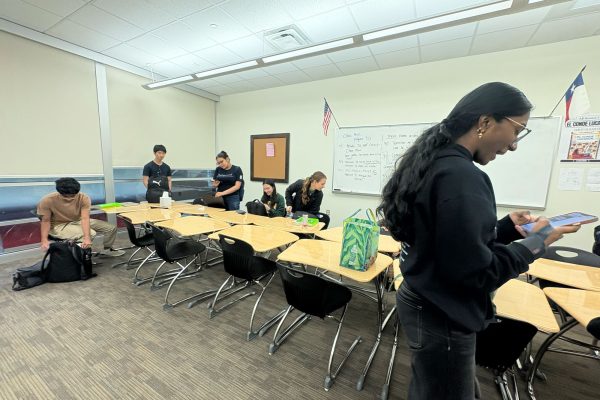Obesity weighs down on nation’s youth
Technology as well as a decrease in physical activity has all played a role in this nation’s epidemic. Childhood obesity has impacted one in every five children between the ages of two and 19.
Having a little extra weight around the waste is somewhat expected as people age. However, for America’s youth, it’s not just extra weight, it’s become an epidemic as nearly one in five children between two and 19 are obese. The issue has caught the attention of healthcare professionals as obesity rates have been climbing over the last five decades.
“One contributing factor is the fact that the way we eat has changed over the last 50 years,” Dr. William Dietz said in an interview with the Center for Disease Control and Prevention. “Americans are eating more processed foods and eating out a lot more frequently. We are surrounded by food. We’re constantly bombarded by it. We’re consuming larger portion sizes and more calories than ever before. Obesity is an epidemic in the United States today and a major cause of death, attributable to heart disease, cancer, and diabetes.”
Although technology has transformed the way teenagers and children learn and communicate with one another in the past decade, it has also had a detrimental effect on their health. The American Academy of Pediatrics estimates that the average child spends more than seven hours a day on entertainment media, like television, video games, phones and other electronic devices.
The increase in technology use goes hand in hand with a decrease in physical activities.
Children aged six and older need at least one hour’s worth of physical activity per day, however only about 42 percent of children six to eleven years of age and 8 percent of children twelve to nineteen years of age are getting the necessary amount of exercise.
Registered Dietician Araceli Vázquez believes that the problem stems from a lack of education about nutrition from parents.
“Children are spending numerous hours of screen time and are physically inactive and parents lack nutrition education from reputable sources,” Vázquez said. “They are misinformed about nutrition from friends, family, internet, and are bombarded by media outlets with commercials that promote and glorify ‘low cost’ high consumption of high-fat- high-calorie-low nutrient foods.”
According to Vázquez, parents can show children how to make the right dietary choices by making it a part of their routine.
“Parents need to encourage children to be more physically active,” she said. “Go to the park and play with their children, enroll them in after-school sport programs and cook meals at home often.”
Texas Woman’s University Nutrition and Food Science professor Dr. Kathleen Davis agrees that parents play an important role in teaching children about nutrition, but she says schools also play an important part in introducing nutritional education as well.
“I think schools can have a positive impact on children’s health in many ways,” Davis said. “Many schools are becoming innovative in moving social services and medical and dental care into school settings. Some have partnered with community agencies or individuals to allow cooking or nutrition classes to occur on site, others have prioritized physical activity or incorporated it into general lessons.”
For former Redhawk Madalyn Roehrig, the message of self-love and acceptance has been taken out of proportion as she believes children and teenagers aren’t as concerned about the foods they are consuming.
“I think a lot of the time children and teenagers don’t really care about what’s in the food they eat in general due to that they’re young and healthy, so their metabolism tends to keep up with all the junk they eat,” Roehrig said. “Culturally and socially, the message of being more accepting and more loving of yourself and things of that nature are being taken out of proportion and is being used as an excuse to not care about what people are eating.”
Eating mainly fruits and vegetables, taking time to make well balanced meals and exercising daily is a way to gain a better understanding of nutrition along with learning what’s best for one’s body.
“For me I enjoy cooking, and I found a love in creating and designing new ways to eat and understanding what’s in my food,” Roehrig said. “I know that I cannot be a successful student and follow through with my schedule if I don’t have the energy or strength to do so, with that I found different things I can do in order to stay strong, like working out and sleeping; it’s just a part of self-control, time management and developing a routine.”
Schools across Frisco ISD have begun to incorporate non-traditional physical education with elementary school children. Pink Elementary School has begun teaching yoga and karate to their kindergarten students in efforts to not only strengthen their physical health, but mental and emotional as well.
“It gives kids an opportunity to breathe and exhale, which sometimes we can’t do when we’re focused on academic rigor,” Allison Ginn, the district’s K-12 Physical Education and Health coordinator said. “We want to make sure we’re offering opportunities to all students and not limiting it to what we traditionally thought of in PE.”
Davis believes that incorporating lessons in an entertaining way is the best method to encouraging students to engage in healthy habits and physical activity.
“Schools can help, just like families, by having teachers and administrators talk about and model the behaviors they want their students to have,” she said. “They can have step contests, getting the most number of steps with their students, have contests to see whether teachers or kids can eat more vegetables, etc. Getting kids healthier doesn’t have to mean lectures.”

Katharina Santos is a senior and staff reporter for Wingspan. She is a member of NHS and president of 3:16 Bible Study. You can often find her sipping...

Eden is entering her second year in Wingspan. She is a hardworking student who tends to draw a lot and work as quickly as she can. She is shy but will...

Morgan Kong is a Senior in Wingspan. She is currently interning at the Frisco Chamber of Commerce for Graphic Design and enjoys listening to music, finding...













